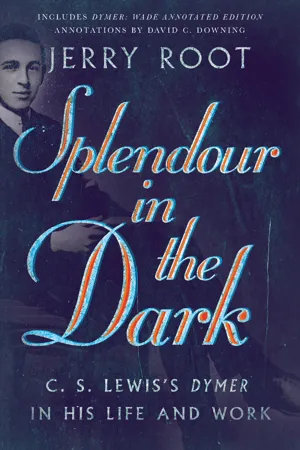
- 256 pages
- English
- ePUB (mobile friendly)
- Available on iOS & Android
About this book
"... Root has done us all an immense service, by rescuing this neglected poem from obscurity and presenting us with an excellent, scholarly edition. ... Everyone who loves Lewis will not only enjoy this book but also find that Root's commentary on Dymer enhances their reading of Lewis's other works as well." – Malcolm Guite, Girton College, Cambridge
Several years before he converted to Christianity, C. S. Lewis published a narrative poem, Dymer, under the pseudonym Clive Hamilton. Later, of course, Lewis became well known for his beloved imaginative stories, such as The Chronicles of Narnia and Till We Have Faces, as well as his ability to defend and articulate the faith in works such as Mere Christianity.
But what about his literary work before his conversion?
In this Hansen Series volume, Jerry Root contends that Lewis's early poem Dymer can not only shed light on the development of Lewis's literary skills but also offer a glimpse of what was to come in his intellectual and spiritual growth—a "splendour in the dark," to borrow one of Lewis's own lines from the poem. Under Root's careful analysis, Dymer becomes a way to understand both Lewis's change of mind as well as the way in which each of us is led on a journey of faith.
This volume also includes the complete text of Dymer with annotations from David C. Downing, co-director of the Marion E. Wade Center.
About the Series
The Hansen Series celebrates the literary and spiritual contributions of seven British authors whose works have captivated readers across generations: Owen Barfield, G. K. Chesterton, C. S. Lewis, George MacDonald, Dorothy L. Sayers, J. R. R. Tolkien, and Charles Williams. These seven authors were all deeply involved in the friendships and intellectual exchanges that shaped the Inklings, a mid-twentieth-century group of Christian writers and thinkers in Oxford, England. This series invites readers to deepen their engagement with these timeless voices and their enduring influence on literature, faith, and the life of the imagination.
Frequently asked questions
- Essential is ideal for learners and professionals who enjoy exploring a wide range of subjects. Access the Essential Library with 800,000+ trusted titles and best-sellers across business, personal growth, and the humanities. Includes unlimited reading time and Standard Read Aloud voice.
- Complete: Perfect for advanced learners and researchers needing full, unrestricted access. Unlock 1.4M+ books across hundreds of subjects, including academic and specialized titles. The Complete Plan also includes advanced features like Premium Read Aloud and Research Assistant.
Please note we cannot support devices running on iOS 13 and Android 7 or earlier. Learn more about using the app.
Information
Dymer
Wade Annotated Edition
David C. Downing
Foreword
Table of contents
- Cover
- Title Page
- Dedication Page
- Contents
- Acknowledgments
- Dymer: Wade Annotated Edition
- Hansen Lectures by Jerry Root
- Contributors
- Index to Dymer: Wade Annotated Edition
- Author Index
- Subject Index
- The Hansen Lectureship Series
- Notes
- Praise for Splendour in the Dark
- About the Author
- More Titles from InterVarsity Press
- Copyright